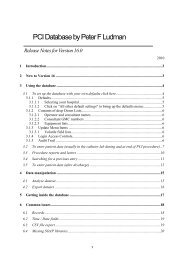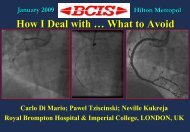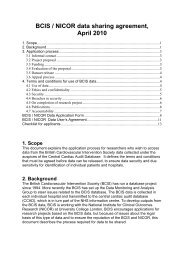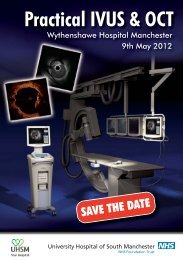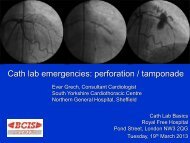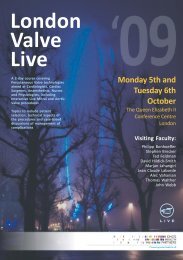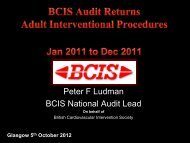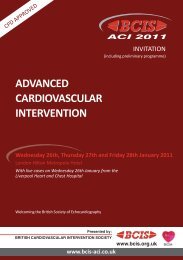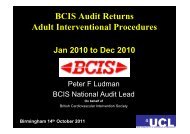Recommendations
ACC/AHA/SCAI PCI Guidelines - British Cardiovascular Intervention ...
ACC/AHA/SCAI PCI Guidelines - British Cardiovascular Intervention ...
- No tags were found...
Create successful ePaper yourself
Turn your PDF publications into a flip-book with our unique Google optimized e-Paper software.
52<br />
Smith et al. 2005<br />
ACC/AHA/SCAI Practice Guidelines<br />
ACC - www.acc.org<br />
AHA - www.americanheart.org<br />
SCAI - www.scai.org<br />
compared with those with an occluded infarct-related artery,<br />
even when LV systolic function is similar (463,464). The<br />
REACT trial (Rapid Early Action for Coronary Treatment)<br />
was a randomized trial comparing medical therapy, immediate<br />
PCI, or repeat fibrinolytic in patients previously treated<br />
with fibrinolytic therapy. Preliminary data at 30 days demonstrated<br />
a significant advantage to rescue PCI [A.H.<br />
Gershlick, oral presentation, American Heart Association<br />
Scientific Sessions, New Orleans, LA, November 2004.]<br />
Rescue (also known as salvage) PCI is defined as PCI within<br />
12 h after failed fibrinolysis for patients with continuing<br />
myocardial ischemia. Rescue PCI has resulted in higher rates<br />
of early infarct-artery patency, improved regional infarctzone<br />
wall motion, and greater freedom from adverse in-hospital<br />
clinical events compared with a deferred PCI strategy or<br />
medical therapy (465). The Randomized Evaluation of<br />
Rescue PCI with Combined Utilization Endpoints (RES-<br />
CUE) trial demonstrated a reduction in rates of in-hospital<br />
death and combined death and HF that was maintained up to<br />
1 year after study entry for patients presenting with anterior<br />
wall STEMI who failed fibrinolytic therapy when performed<br />
a mean of 8 h after symptom onset (466,467). Improvement<br />
in TIMI grade flow from 2 to 3 may offer additional clinical<br />
benefit. Similar data are not available for patients with<br />
nonanterior STEMI.<br />
A major problem in adopting a strategy of rescue PCI lies<br />
in the limitation of accurate identification of patients in<br />
whom fibrinolytic therapy has not restored antegrade coronary<br />
flow. Unless unsuccessful fibrinolysis is recognized and<br />
corrected quickly (within 3 to 6 h of onset of symptoms), salvage<br />
of ischemic myocardium is unlikely. Unfortunately,<br />
clinical markers of reperfusion, such as relief of ischemictype<br />
chest discomfort, partial resolution of ST-segment elevation,<br />
and reperfusion arrhythmias, have limited predictive<br />
value in identifying failure of fibrinolysis (468). Immediate<br />
catheterization of all patients after fibrinolytic therapy to<br />
identify those with an occluded infarct-related artery in a<br />
prior era in which the practice of PCI was less mature failed<br />
to show a significant benefit and was associated with bleeding<br />
complications. However, there was no specific study<br />
using stents and current pharmacotherapy. This strategy is<br />
being re-evaluated in clinical trials testing facilitated PCI in<br />
the contemporary PCI setting.<br />
Even in the patient with documented failure of fibrinolysis,<br />
rescue PCI has limitations. First, because extensive myocardial<br />
necrosis occurs when coronary occlusion has been present<br />
for more than 3 h (469), PCI may not salvage a substantial<br />
amount of myocardium, considering the time delay associated<br />
with presentation of the patient to the hospital after<br />
onset of symptoms, infusion of the fibrinolytic agent, recognition<br />
of failed fibrinolysis, and subsequent initiation of PCI.<br />
Second, rescue PCI fails to reestablish antegrade coronary<br />
flow in about 10% of patients, and reocclusion of the infarctrelated<br />
artery occurs in as many as 20% of the remainder<br />
(470), although GP IIb/IIIa inhibitors and stent implantation<br />
may have improved these results. Third, unsuccessful rescue<br />
PCI is associated with a high mortality (471,472). Finally,<br />
coronary reperfusion occurs over the subsequent h after fibrinolytic<br />
therapy in many patients. Although infarct-related<br />
artery patency is achieved in only 50% to 85% of patients 90<br />
min after fibrinolytic therapy, it rises to 90% by 24 h (473).<br />
Such “late” reperfusion may improve survival without the<br />
risk of invasive procedures coupled with fibrinolytic therapy.<br />
Confounding the issue, both fibrinolysis and PCI may successfully<br />
restore flow in the epicardial artery but fail to<br />
improve microvascular perfusion.<br />
Hours to Days After Failed Fibrinolysis<br />
Patency of the infarct-related artery is an important predictor<br />
of mortality in survivors of STEMI (462,463,474).<br />
Compared with those with a patent infarct artery, survivors<br />
of STEMI with a persistently occluded artery after fibrinolysis,<br />
PCI, or no reperfusion therapy have 1) increased LV<br />
dilatation (475), 2) a greater incidence of spontaneous and<br />
inducible ventricular arrhythmias (476), and 3) a poorer<br />
prognosis (477). On the basis of observational and experimental<br />
data, it has been hypothesized that infarct artery<br />
patency may favorably influence LV remodeling and electrical<br />
stability, even if accomplished at a time when salvage of<br />
ischemic myocardium is unlikely (i.e., more than 12 h to<br />
days after coronary artery occlusion). Five small randomized<br />
trials, which enrolled a total of 562 patients, have directly<br />
tested the hypothesis that mechanical opening of persistent<br />
total occlusions late after MI will improve long-term LV<br />
remodeling and clinical outcomes (the late open artery<br />
hypothesis). Most studies enrolled a combination of patients,<br />
including those who had failed fibrinolysis and those who<br />
had not received reperfusion therapy (478-480), with a range<br />
from almost no fibrinolytic therapy (481) to fibrinolytic therapy<br />
in nearly all patients (482). There was wide variation in<br />
the effect of routine PCI compared with medical therapy only<br />
on LV size and function. Most studies showed no significant<br />
differences between the treatment groups (478,479). One<br />
single-center study of 83 patients with LAD occlusions<br />
reported improved LV volumes and clinical outcomes (composite<br />
of HF, MI, and death) at 6 months in the PCI group<br />
(481). In contrast, a multicenter study of 66 patients with<br />
LAD occlusions reported significantly worse LV remodeling,<br />
with progressive LV dilation at 1 year and more clinical<br />
events in the PCI group than in those assigned to optimal<br />
medical therapy alone (482). The latter included very high<br />
rates of beta-blocker and angiotensin converting enzyme<br />
inhibitor use. The largest multicenter study, DECOPI<br />
(DEsobstruction COronaire en Post-Infarctus), enrolled 212<br />
patients and reported no difference in the primary end point,<br />
the composite of death, ventricular tachycardia, and MI at 6<br />
months (483). Stents were used in 80% of patients in the PCI<br />
group, and GP IIb/IIIa antagonists were used in 9%. The<br />
study reached less than one third of the target sample size<br />
and was severely underpowered, as were all the other studies,<br />
to assess clinical events.<br />
Selection of patients for revascularization based on viability<br />
testing has gained a great deal of investigational support,<br />
i.e., delayed enhancement or low-dose dobutamine cardiac



